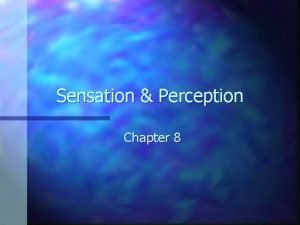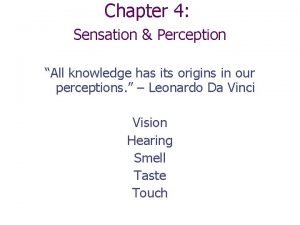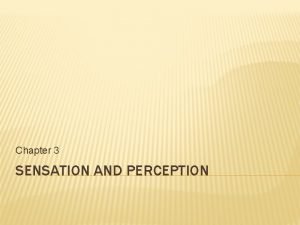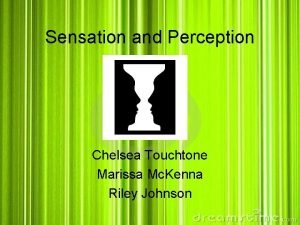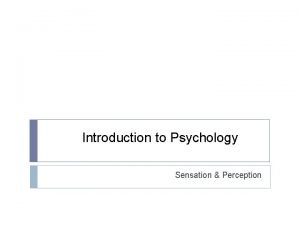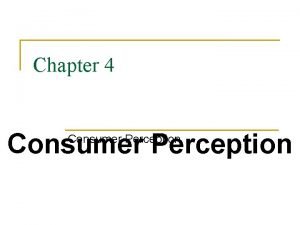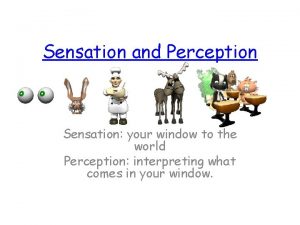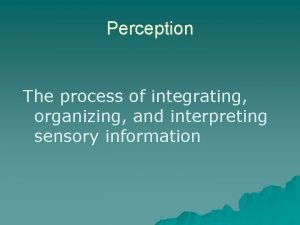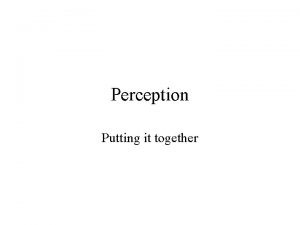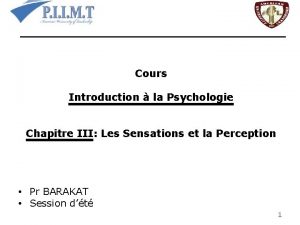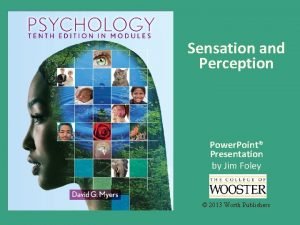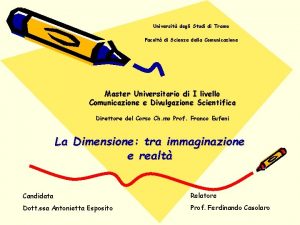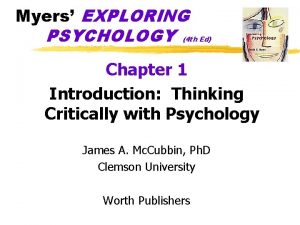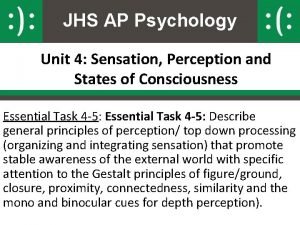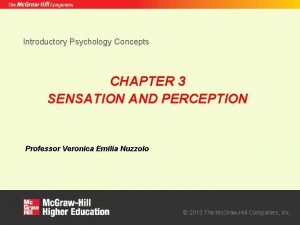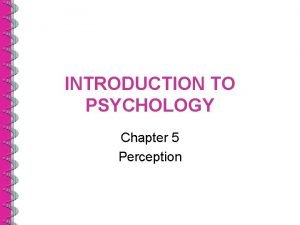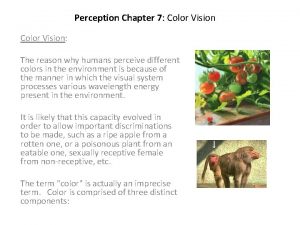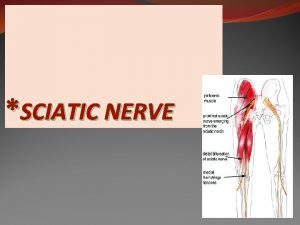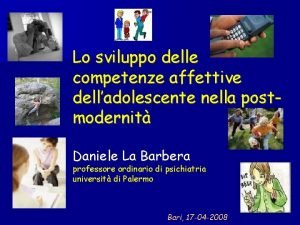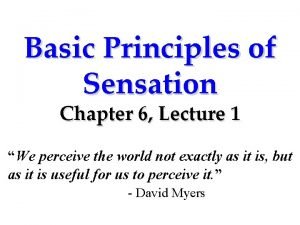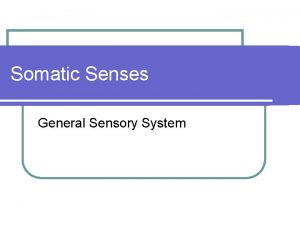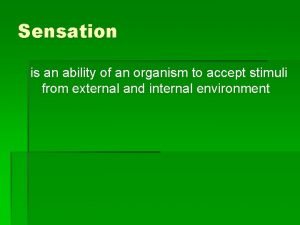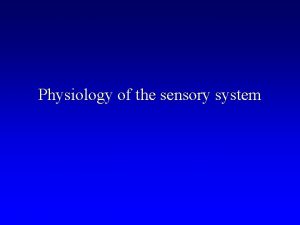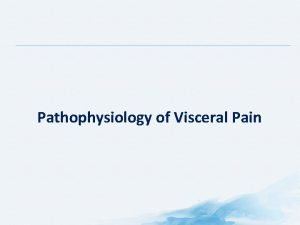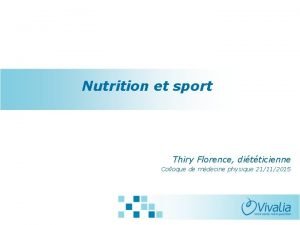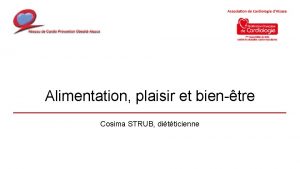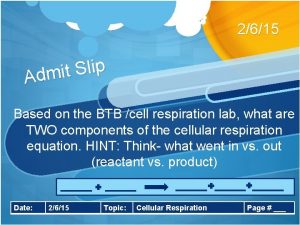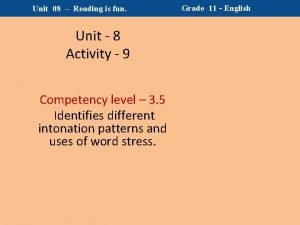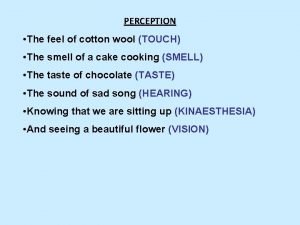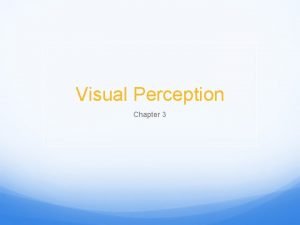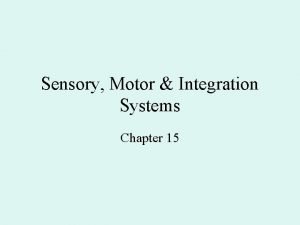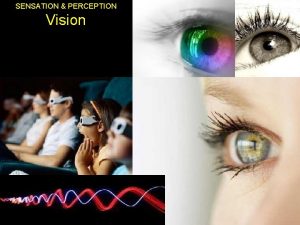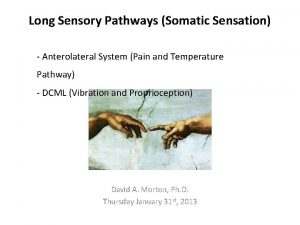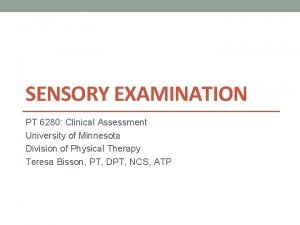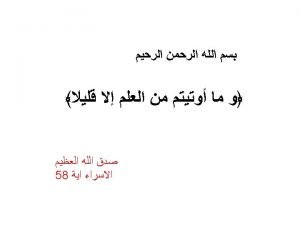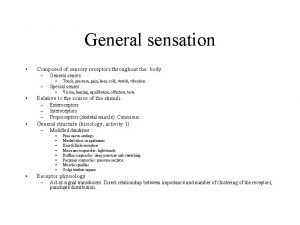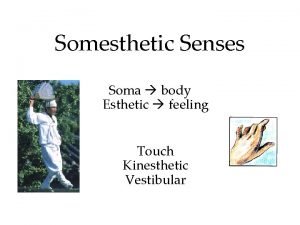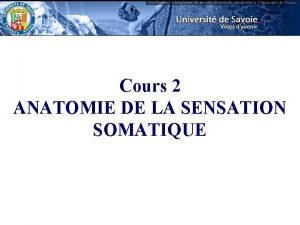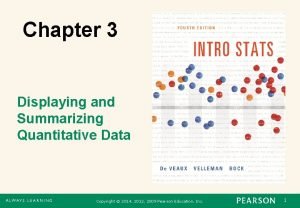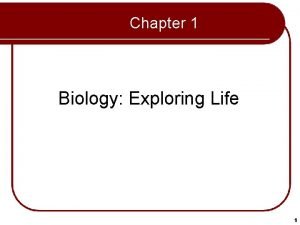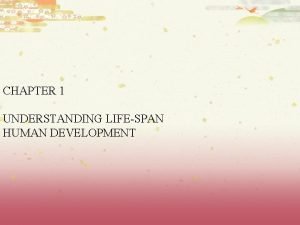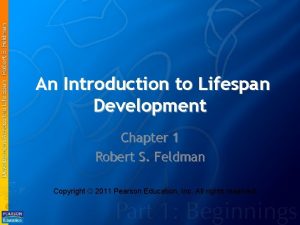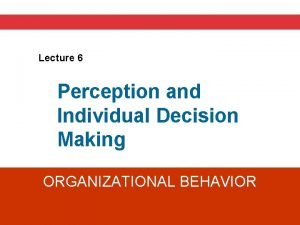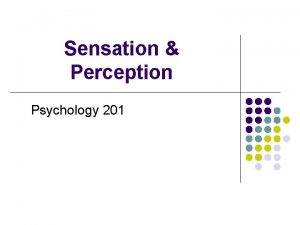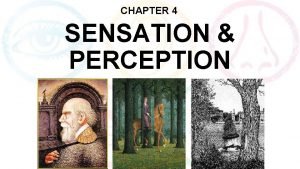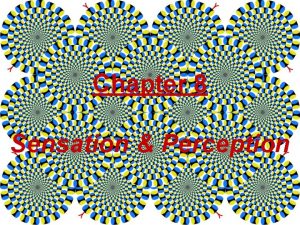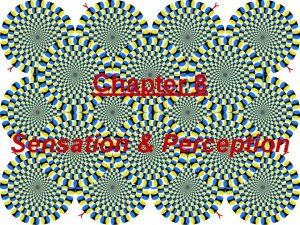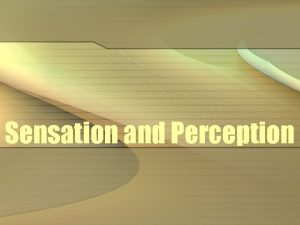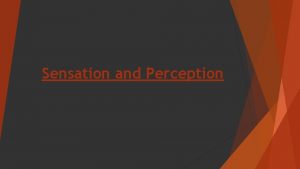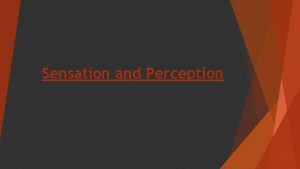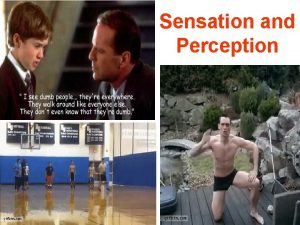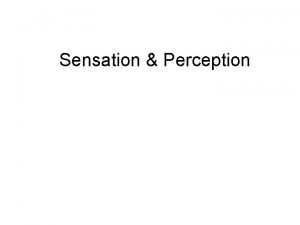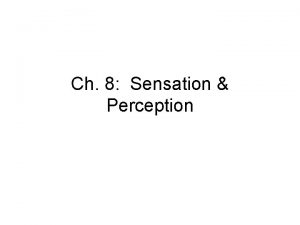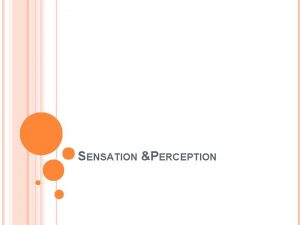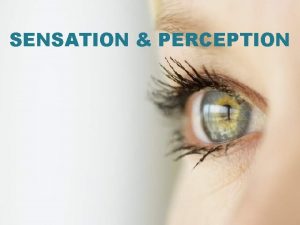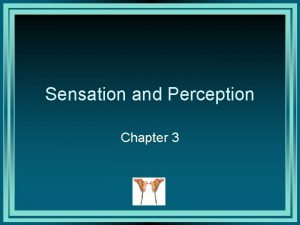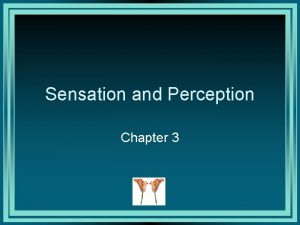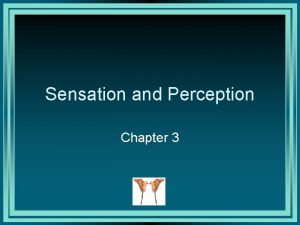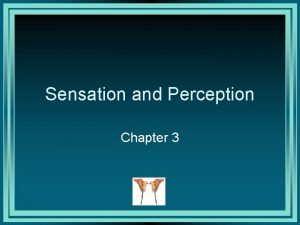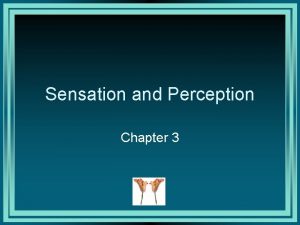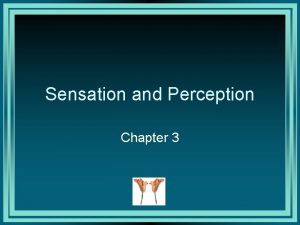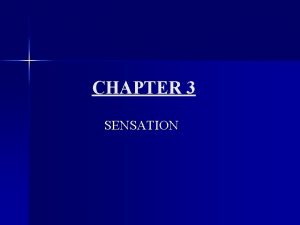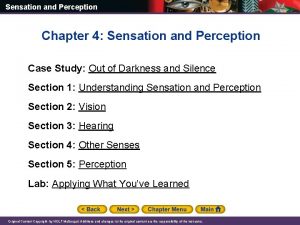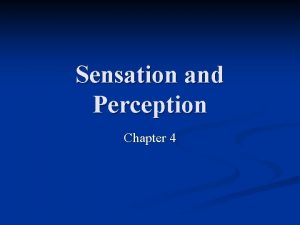Exploring Psychology CHAPTER 4 Sensation and Perception Necker












































































- Slides: 76

Exploring Psychology, CHAPTER 4: Sensation and Perception

Necker Cube

Bell Work 11/3/14 • Which one of your five senses (vision, hearing, taste, touch, smell) is the most important to you? Why?

How many squares do you see?

Sensation and Perception • Sensation – The processes by which our sense organs receive information from the environment. • Perception – The processes by which people select, organize, and interpret sensations.

Processes of Sensation & Perception

Read the following as quickly as possible • Th. Ec. Owg. Avec. Ola. • . rat eht saw tac eh. T

Bell Work 11/6/14 • Topic: “Useless” Sense • If you had to give up one of your 5 senses, which one would it be & why?

Cna Yuo Raed Tihs? • i cdnuolt blveiee taht I cluod aulaclty uesdnatnrd waht I was rdanieg. The phaonmneal pweor of the hmuan mnid, aoccdrnig to a rscheearch at Cmabrigde Uinervtisy, it dseno’t mtaetr in waht oerdr the ltteres in a wrod are, the olny iproamtnt tihng is taht the frsit and lsat ltteer be in the rghi t pclae. The rset can be a taotl mses and you can sitll raed it whotuit a pboerlm. Tihs is bcuseae the huamn mnid deos not raed ervey lteter by istlef, but the wrod as a wlohe. Azanmig huh? yaeh and I awlyas tghuhot slpeling was ipmorantt! if you can raed tihs forwrad it.

Measuring Sensory Experience Thresholds • Absolute Threshold – The smallest amount of stimulation that can be detected. • Just Noticeable Difference (JND) – The smallest amount of change in a stimulus that can be detected.

Sensation & Perception Basics • Sensory Adaptation – Gradual loss of attention to unneeded or unwanted sensory information. • Sensory Interaction – The interaction of the senses to each other and how they influence each other. – For example, taste and smell are two senses that work together. When you have a cold, food tastes bland. Other examples?

Absolute Thresholds • Vision: A single candle flame from 30 miles on a dark, clear night • Hearing: The tick of a watch from 20 feet in total quiet • Smell: 1 drop of perfume in a 3 -room apartment • Taste: 1 teaspoon sugar in 2 gallons of water • Touch: The wing of a bee on your cheek, dropped from 1 cm

Bell Work – 11/7/14 • Topic: Interaction • Describe a situation in which your senses (at least 2 of them) interacted in the last few days.

Bell Work – 11/10/14 • http: //www. youtube. com/watch? v=8 y 16 efiy 4 Os&safe=active • http: //www. youtube. com/watch? v=h 9 ZGKALMMuc&safe=active • http: //www. youtube. com/watch? v=5 Qksq. Ktar. Lk&safe=active • Listen to the songs clips & describe how the perceptions of these 2 songs could be quite different depending on one’s age (17 vs. 77), life experience, preferences, etc.

Bell Work – 11/11/14 • Listen to the following speeches by JFK & Hitler. – What perceptions were there to JFK’s speech? – What perceptions were there to Hitler’s speech? – How do our environments affect our perceptions? – http: //www. youtube. com/watch? v=2 c. VSas. BA-vg&safety_mode&safe=active (3: 30 – end) – http: //teachertube. com/view. Video. php? video_id=93369&title=Adolf_Hitler

Vision The Visible Spectrum http: //www. youtube. com/watch? v=gtg. BHs. Sz. CPE (6: 05) http: //www. youtube. com/watch? v= gtg. BHs. Sz. CPE •

White Light • White light – Light as it originates from the sun or a bulb before it is broken into different frequencies. It is reflected into all the colors we see: • • • Red Yellow Green Blue Violet

Vision Structures of the Human Eye

Vision Structures of the Human Eye • Cornea – Clear outer covering; bends light to focus it in the eye; fluid behind it • Iris – Colored circular muscle; opens & closes to control the amount of light getting into the eye; changes the “size” of the pupil. • Pupil – The hole in the iris through which light passes. (Demo)

Vision Structures of the Human Eye • Lens – The structure that focuses light on the retina. – If the lens is not shaped correctly, then: • Near-sightedness – Can see things NEAR, but not far away • Far-sightedness – Can see things FAR, but not near you

Normal (Perfect) Vision

Farsighted Vision

Nearsighted Vision

Online Eye Exam • http: //www. eyeexamonline. com/exam-righteye_what-letters-are-clear. html

• Retina – Back of the eye; contains millions of receptors for light – These receptors are called: • Rods – Visual receptors most sensitive to violet-purple wavelengths; sensitive for night vision; located on peripheral edges of retina; “sees” black & white • Cones – Visual receptors that respond during daylight; “sees” color – Cones – Color – Center (of retina)

Vision The Retina • The rear of the eye where rods and cones convert light into neural impulses.

Vision Visual Pathways Optic Nerve • Pathway that carries visual information from the eyeball to the brain. Kassin, Essentials of Psychology - © 2004 Prentice Hall Publishing

Blind Spot Demonstration • One of the most dramatic experiments to perform is the demonstration of the blind spot. The blind spot is the area on the retina without receptors that respond to light. Therefore an image that falls on this region will NOT be seen. It is in this region that the optic nerve exits the eye on its way to the brain. To find your blind spot, draw this image on a piece of paper approximately 6 -8 inches apart: ● + • Close your right eye. Hold the image about 20 inches away. With your left eye, look at the +. Slowly bring the image closer while looking at the +. At a certain distance, the dot will disappear from sight. . . this is when the dot falls on the blind spot of your retina. Reverse the process. Close your left eye and look at the dot with your right eye. Move the image slowly closer to you and the + should disappear.

So what causes color blindness? • Color Blindness – The inability to perceive certain colors. 3 Types: – Red/Green: Most common type; Red or Green cone system does not respond – Blue/Yellow: Blue cone system does not respond – Complete Color Blindness: Very rare; only the rods are working

Color Blindness • Examples of how the world looks http: //www. vischeck. com/examples/ • http: //www. youtube. com/watch? v=y. EIM 4 j m. K 1 F 0&feature=email 6: 28 – Color Vision Test • Or http: //www. prokerala. com/health/eyecare/eye-test/color-blindness-test. php

Bell Work – 11/10/14 • http: //www. youtube. com/watch? v=8 y 16 efiy 4 Os&safe=active • http: //www. youtube. com/watch? v=h 9 ZGKALMMuc&safe=active • http: //www. youtube. com/watch? v=5 Qksq. Ktar. Lk&safe=active • Listen to the songs clips & describe how the perceptions of these 2 songs could be quite different depending on one’s age (17 vs. 77), life experience, preferences, etc.

Vision The Color Wheel • Spectral colors vary from violet-blue to red – 470 to 700 nanometer wavelength • Opponent colors are directly across from each other on the wheel.

Bell Work – 11/12/14 • Describe the difference between being nearsighted and far-sighted.

Opponent-Process Theory • Color Vision - Derived from three pairs of opposing receptors; Opponent colors are: » Red & Green » Blue & Yellow » Black & White • This theory explains afterimages - a visual sensation (image) that remains after prolonged exposure to and removal of a stimulus - Now you see it, now you don’t…. . or do you? – What causes afterimages? Write the answer in your notes.



World’s Quietest Room • https: //www. youtube. com/watch? v=m. XVGI b 3 bz. HI (10: 32)

Hearing: The Human Ear (See pg. 101 & label what you can) Audition • The sense of hearing

Label the Ear Diagram

Bell Work 11/14/14 • How old are your ears? Watch & listen to the following video clip & write down the highest Hz you could hear. – https: //www. youtube. com/watch? v=Vxcbpp. CX 6 Rk (1: 37)

Process of Hearing • Sound is collected by the pinna (visible part of the ear) & directed through the outer ear canal. The sound makes the eardrum vibrate, which in turn causes a series of three tiny bones (the hammer, the anvil, & the stirrup) in the middle ear to vibrate. The vibration is transferred to the snailshaped cochlea in the inner ear; the cochlea is lined with sensitive hairs which trigger the generation of nerve signals that are sent to the brain. • https: //www. youtube. com/watch? v=kt 1 p. Tcfst. C 8 (23: 03) Bill Nye

Parts of Ear • Outer Ear: – Pinna - the visible part of the outer ear. It collects sound and directs it into the outer ear canal – Eardrum - (tympanic membrane) a thin membrane that vibrates when sound waves reach it. • Middle Ear: 3 bones that carry sound waves • Inner Ear: – Cochlea - a spiral-shaped, fluid-filled inner ear structure; it is lined with cilia (tiny hairs) that move when vibrated and cause a nerve impulse to form. • Auditory Nerve – carries sounds to brain for interpretation

Hearing: Auditory Localization – The ability to judge from which direction a sound is coming • Sounds from different directions are not identical as they arrive at left and right ears. • The brain calculates a sound’s location by using differences in timing and intensity.

Hearing – Measured in Decibels Common Sounds and the Noise They Produce

Hearing Disabilities • Conduction Hearing Loss – Caused by damage to the eardrum or bones in the middle ear. • Sensorineural Hearing Loss – Caused by damage to the structures of the inner ear.

Final Notes on Audition • Pitch – how high or low a sound is. • Timbre – the complexity (variations) of a tone. – Listen http: //www. youtube. com/watch? v=NIe 3 jkk. TGo. M&safety_mode&safe=ac tive (0: 24) • Intensity – volume, how loud or soft

Bell Work 11/17/14 • Would you like to live a pain-free life? Think about it. Why or why not?

Other Senses Olfactory System

Olfaction • Olfaction – the sense of smell • Most animal-like of our senses • Cilia (hair cells) collect molecules of odor. Then an electrical signal is sent to the olfactory bulbs which sends the message to the brain for interpretation. Sent to the limbic system (memories)! Only sense that bypasses the thalamus of the brain. Goes directly to limbic system.

What about pheromones? • Pheromones – Odor chemicals that communicate a message. • http: //www. youtube. com/watch? v=P 9 v. Zou UQjfc&safety_mode&safe=active (3: 23) • Purchase for only $99! • You’ll be irresistible!

Other Senses Taste • Taste buds – Where located? • This is a photograph of the tongue’s surface (top), magnified 75 times. • 10, 000 taste buds line the tongue and mouth. • Children have more taste buds than adults do. • There are four primary tastes: sweet, salty, sour, and bitter.

A th 5 Taste? • Umami - pleasant savory taste (salty & meaty) – Found in meats & vegetables – MSG flavoring – http: //www. youtube. com/watch? v=i. Yq 1 Git. M 4 xg&safe ty_mode=true&persist_safety_mode=1&safe=active (2: 18) – http: //www. youtube. com/watch? v=8 H_ya. BKDz. I&feature=related&safety_mode=true&pers ist_safety_mode=1&safe=active (1: 53)

Touch – Cutaneous Sense • 3 Skin Receptors for Touch: – Pressure – Pain – Temperature: Warmth & Cold – Http: //www. youtube. com/watch? v=J 2 ECNZA 60 XE (5: 41) Gabby - Congenital Insensitivity to Pain – http: //www. youtube. com/watch? v=T 7 Oo. BLSk. Q 34&sa fe=active (5: 45) 20/20 with young Gabby

Other Senses Coordination • Kinesthetic System – Structures distributed throughout body that sense position and movement of body parts. • Vestibular System – The inner ear and brain structures that afford a sense of equilibrium. – Demo – Next slide

Importance of the Vestibular Sense Stand up & lift one leg. Notice how your body automatically adjusts to retain your balance in this somewhat precarious position. Now repeat this exercise with your eyes closed. You should find the task to be much more difficult. Vision clearly aids the vestibular sense in maintaining body balance. As one final illustration, spin around rapidly & then try to stand on one leg. The unusual stimulation of your vestibular sense caused by spinning around will make the task very difficult, even with your eyes open. Thus, the vestibular sense must be very important for maintaining our balance.

Bell Work 11/18/14

Bell Work 11/19/14: NECKER CUBE

Bell Work 11/20/14 • Gestalt – Closure: What do you see? Why do you see that?

Perception • Perception is always a matter of interpretation & expectations. • Perceptions are UNIQUE! • My perceptions are different from yours which are different from hers which are different from his……. .

5 Perceptual Constancies • Size Constancy – The tendency to view an object as constant (the same) in size despite changes in the size of the retinal image. • Color Constancy – The ability to perceive an object as the same color regardless of the environment. Kassin, Essentials of Psychology - © 2004 Prentice Hall Publishing

5 Perceptual Constancies • Brightness Constancy – Ability to keep an object’s brightness constant despite a changing environment. • Shape Constancy – Ability to know that an object’s shape is the same regardless of how it is viewed. • Space Constancy – Ability to keep objects in the environment steady by perceiving ourselves or outside objects as moving.

Depth and Dimension • Depth Perception – The use of visual cues to estimate depth and distance. • Visual Cliff Experiment – Done with babies to test depth perception & when children have this ability. – Around 8 months of age. http: //www. youtube. com/watch? v=D rzmv. I 6 i. Mr. E&safety_mode=true&persist_ safety_mode=1&safe=active (1: 15 -end)

Cues for Depth Perception • 2 Binocular (requires both eyes) Cues: • Convergence – A binocular cue involving the turning inward of the eyes as an object gets closer. • Retinal (Binocular) Disparity – The difference (disparity) in the images the retina receives. Each retina “receives” a different image & the brain brings them together & determines the depth. (Demo)

Cues for Depth Perception • Texture Gradient - Monocular (1 eye) Cue – The closer the object, the more texture (detail) we can see. The farther away the object, the less texture (detail) we can see.

Cues for Depth Perception • Relative Size (of similar objects) – the smaller the image, the farther away it is.

Cues for Depth Perception • Overlapping – We see complete objects as being closer & those partially hidden as farther away.

Perceptual Organization • Gestalt Psychology – School of thought rooted in the idea that the whole is different from the sum of its parts. • Gestalt: An organized whole, shape, or form • How our mind likes to “view” or perceive what we sense – see, hear, etc.

Gestalt Laws of Grouping • Proximity – Grouping things by how close together they are. – Seeing 3 pair of lines in A • Similarity – Grouping “like” things – Seeing columns of orange and red dots in B • Closure – Filling in missing details – Seeing a horse in D

Gestalt Principles • http: //www. youtube. com/watch? v=1 j. Xe. VS 8 j. K 18&safety_mode&safe=active (4: 35) • Illusion – when we perceive something inaccurately.

Perceptual Organization – Reversible Figure: Illusion that one can perceive in different ways by reversing figure and ground. Kassin, Essentials of Psychology - © 2004 Prentice Hall Publishing

Reversible Figures

Perceptual Set Context Effects • The same physical stimulus can be interpreted differently depending on perceptual set, e. g. , context effects. • When is the middle character the letter B and when is it the number 13?

The Müller-Lyer Illusion – Illusion in which the perceived length of a line is altered by the position of other lines that enclose it; one appears longer than the other, but they are both equal

Well-known Illusions • Muller-Lyer Illusion: http: //www. youtube. com/watch? v=0 k. Le. EJd. RUSw&safe=active Beginning-2: 54; 3: 50 -5: 35 • Ames Room Illusion: http: //www. youtube. com/watch? v=h. CV 2 Ba 5 wrcs&safe=active (1: 49)

The Case for ESP • Extrasensory Perception (ESP) – The ability to perceive something without ordinary sensory information. – This has not been scientifically demonstrated. • Four types of ESP: – Telepathy – Mind-to-mind communication – Clairvoyance – Perception of remote events – Precognition – Ability to see future events – Psychokinesis – Physical control of events

Are you psychic? Can you predict the order in which these images will appear? Test yourself in the following link: http: //www. youtube. com/ watch? v=HBJ 84 R-NCXM (4: 24)
 Copyright ?
Copyright ? Chapter 5 sensation and perception
Chapter 5 sensation and perception Chapter 3 sensation and perception
Chapter 3 sensation and perception Chapter 6 sensation and perception
Chapter 6 sensation and perception Five basic taste sensations
Five basic taste sensations Chapter 8 sensation and perception
Chapter 8 sensation and perception Chapter 4 sensation and perception
Chapter 4 sensation and perception Chapter 3 sensation and perception
Chapter 3 sensation and perception What are the gestalt principles of visual perception?
What are the gestalt principles of visual perception? Ap psych sensation and perception
Ap psych sensation and perception What is sensation and perception
What is sensation and perception Sensation & perception crossword review
Sensation & perception crossword review Sensation and perception
Sensation and perception Consumer perception definition
Consumer perception definition Webers law
Webers law Opponent process theory
Opponent process theory Sensation and perception uu
Sensation and perception uu Perceptual system
Perceptual system Cours sur la perception en psychologie
Cours sur la perception en psychologie Perception vs sensation
Perception vs sensation Face recognition
Face recognition Ipercubo dalì
Ipercubo dalì Lisianski island
Lisianski island Uih necker
Uih necker Exploring psychology chapter 1
Exploring psychology chapter 1 Depth perception ap psychology
Depth perception ap psychology Perception meaning in psychology
Perception meaning in psychology Categorical perception psychology
Categorical perception psychology Motion parallax definition psychology
Motion parallax definition psychology Two factor theory psychology
Two factor theory psychology Color vision
Color vision Horizontal e vertical
Horizontal e vertical Sensation seeking
Sensation seeking Sciatic nerve roots
Sciatic nerve roots Sensation seeking significato
Sensation seeking significato Principles of sensation
Principles of sensation Thermoreceptors
Thermoreceptors Types of sensation
Types of sensation Classification of sensation
Classification of sensation Viscerosomatic levels
Viscerosomatic levels Ditticienne base sur coute sensation
Ditticienne base sur coute sensation Ditticienne base sur coute sensation
Ditticienne base sur coute sensation What causes the burning sensation in your muscles
What causes the burning sensation in your muscles Reading 08
Reading 08 Walking on cotton wool sensation
Walking on cotton wool sensation Perception gestalt principles
Perception gestalt principles Sensation
Sensation Colour design: theories and applications
Colour design: theories and applications Dcml sensation
Dcml sensation Jung thinking feeling sensing intuiting
Jung thinking feeling sensing intuiting Le dermatomes
Le dermatomes Touch receptor in skin
Touch receptor in skin Somatic pain pathway
Somatic pain pathway Inner hair cell
Inner hair cell What is somesthetic senses
What is somesthetic senses Sensation somatique
Sensation somatique Chapter 26 exploring the universe answers
Chapter 26 exploring the universe answers Exploring religions chapter 4 large
Exploring religions chapter 4 large Physical development
Physical development Exploring globalization textbook pdf chapter 11
Exploring globalization textbook pdf chapter 11 Judaismn
Judaismn Exploring the religions of our world chapter 1 pdf
Exploring the religions of our world chapter 1 pdf Exploring the religions of our world
Exploring the religions of our world Exploring the religions of our world pdf
Exploring the religions of our world pdf Chapter 3 exploring quantitative data answers
Chapter 3 exploring quantitative data answers Chapter 2 exploring the americas study guide
Chapter 2 exploring the americas study guide Chapter 2 exploring the americas answer key
Chapter 2 exploring the americas answer key Chapter 1 biology exploring life
Chapter 1 biology exploring life Exploring lifespan development chapter 1
Exploring lifespan development chapter 1 Sociocultural graded influences
Sociocultural graded influences Positive psychology ap psychology definition
Positive psychology ap psychology definition Social psychology ap psychology
Social psychology ap psychology Introspection method in psychology
Introspection method in psychology Social psychology is the scientific study of:
Social psychology is the scientific study of: Health psychology definition ap psychology
Health psychology definition ap psychology Preference inventory
Preference inventory Perception and individual decision making
Perception and individual decision making





